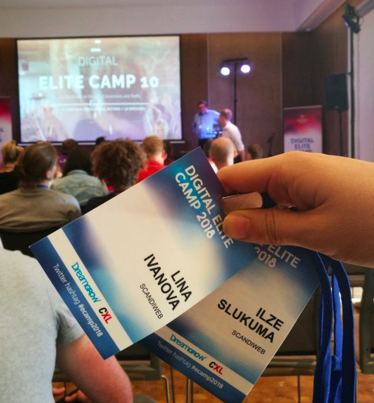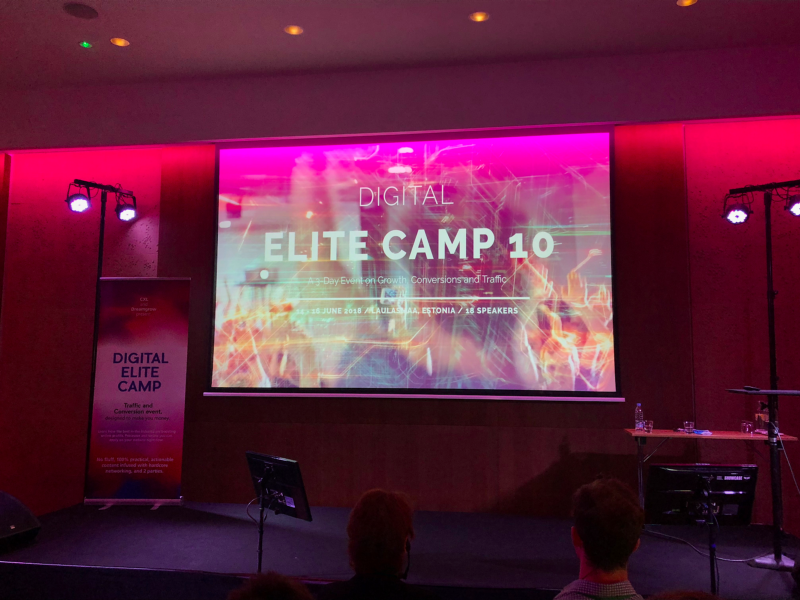It is impossible to count how many times the abbreviations and terms A/B, CR, UX, GA, GTM, cross-device, surveys, bugs, eCommerce etc. etc. etc. were mentioned during Digital Elite Camp at cosy Laulasmaa in Estonia.
That is what happens when you put together 170 people from all over the world who are passionate about CRO and make sure that industry leaders deliver insightful talks to them for 3 days. It was also made sure by the organizers that all these 170 people are well taken care of and could enjoy pauses between the talks to chat with other participants and process all the insights gained from each speaker.
Two representatives from Scandiweb Marketing team had an opportunity to join the conference. And we would like to share with you the key takeaways.

First of all, we have to admit that A/B tests definitely was a top topic during the event. In a nutshell that is the core of optimizers job — come up with hypothesis what and why should be improved on a website, and then A/B test it. And either implement or not based on results of the test.
Clients might ask: “Hey! If you have run many tests you might have come up with some patterns already and skip the testing part.” Unfortunately, as always it is not that simple. CXL, one of the best known CRO agencies with a long history of running A/B tests shared that they have tried to find the patterns which might be applicable to any website without testing, and failed. What works on 5 websites not necessarily will work on 6th. Without a doubt, A/B testing was an important topic and included in a quite a few of the presentations.
However, besides that there a are lot of other amazing things happening in CRO industry.
So what are some top conversion optimisation experts talking about besides A/B tests?
1. Most probably you don’t know your user
As told by Alexa Hubley,
Unbounce faced a situation when despite the popularity of their landing page builder, the usage of pop-up and sticky bars functionality was low — only 11% of their landing page builder users were using it. The problem was that they basically had 1.11 products. Unbounce worked hard to understand the reasons and got great insights from a simple 2 question Hotjar survey. They asked if users have built a pop-up or a sticky bar using the tool and if not, why? And almost half of the users answered that they didn’t know that such functionality existed. If they would not have asked customers they might have come up with plenty of the wrong hypotheses. When you optimize without doing a user research it’s gambling according to Els Aerts from AGConsult. Yes, user research was another big topic of the conference.
Booking.com are basically the heroes of A/B testing. They can afford to A/B test a bug fix before deployment. In this way they ensure that a bug fix won’t harm anything else on the website. But most businesses wouldn’t be able to afford such approach. Then to succeed you have to embrace customer experience as part of your business, listen and talk with your customers. And this idea of being user-centric was appearing in the majority of talks.
2. Bug hunter approach
What would you think if seeing a dirty floor in a shop covered with a dog poop? Is staff lazy? The management doesn’t care about customers? Nothing good, right? Therefore, if we believe that such situation is unacceptable in the offline environment why we often consider it to be OK to have a small bugs poops all around our websites? It shows our attitude towards customers in the exact same way.
This amazing analogy was shared by Craig Sullivan, one of the most experienced optimizers out there (and also a great DJ who knows how to move the dancefloor, as it was discovered during the conference). And we can only agree that before making major improvements to the website make sure that:
- Your Google Analytics setup is reporting the correct data
- There are no bugs which result in website leaking money. For example, it is not impossible to use a webpage on a mobile device because there is a pop-up which you can’t close.
3. ALEXA, buy me a book! Or how to get ready for AI Voice Search?
A practical talk delivered by Robin Langfield Newnham, creative Strategist at Kaizen. According to O&C Strategy Consultants voice shopping is estimated to hit $40 billion by 2022 in the UK and USA. That is big.
Besides activities like shopping users use voice search & assistants to find answers to their questions, e.g., what is the widest waterfall in Europe? which is the nearest restaurant? is it cold outside? And to make sure that users end up on your website the good, old SEO might help:
- Unfortunately, it’s not possible to precisely estimate what percentage of organic traffic already comes from voice search in GA. But often users are asking questions (e.g.:”Who is the founder of Airbnb?”) instead of speaking in keywords (search, founder, Airbnb). So if you see a potential in voice search for your business and change H2 in pages from statements to questions, and provide a paragraph with an answer — half of the job is done.
- Also, implementing Schema.org markup will help search assistants to navigate your content and answer questions with the right statement. So that’s another reason to work on SEO of your website.
- And we can mention it again — this is big. Great that also such topic was covered during the conference, giving an insight of not just what is happening today, but also what might change tomorrow or at least in the following years.
4. Good copywriting means more than just tweaking random words on pages
Momoko Price, product messaging and copywriting consultant, is sure about that. The internet is overflowing with advice on how to sell your product with using a copy. Then we write something using that our found advice or our own thoughts, since we think we know how to do it best, because conversion copywriting means testing, a lot of A/B tests, test by test, test which CTA button text works better, test which value proposition copy works and looks the best, right? But how do we know this is really the right message to use to sell our product?
The reality is that effective copywriting — it’s the art of understanding your customers’ mindset … and reflecting it right back to them. To achieve it we need to understand what are the customer’s pain points, risks and anxieties. Of course, there are methods to do that which we are all aware of — interviews, surveys, user tests, pools.
Having said all that, Momoko also shared an interesting and quite popular, but relatively new copywriting technique — Online Review Mining. That is right! You can go to an online store of your nearest competitor product and go through the reviews of the product. What are the customers writing? What did they find was the best about the product? What did they like? What they find could have been better? You can straight up steal many valuable keywords from these reviews for your next sales copy. If your new business has some money to spend on a good copywriting message, you can use pay-per-response surveys — a very underestimated way to rely on.
But for already well established businesses to check their assumptions they can simply use a well-designed survey on their existing customers.
5. We all fail. Sometimes
No surprise to us, but conversion optimizers are not afraid to talk about failure. To embrace it. And it was done also at the conference. It is important to admit that you have failed, find the reason WHY and do something about it. Because nobody else will.
According to Karl Gilis and his many years spent as conversion optimization expert and information architect, there are (at least) 8 reasons WHY we fail:
- not knowing the basic principles
- believing that design should be visually impressive
- believing whatever we WANT to believe
- not knowing what “start with your customer” actually means
- wanting to impress
- not understanding what power the words can have
- never giving compliments
- being too egocentric
Having just named all these points, we again get to the conclusion that the biggest mistakes we can make as conversion optimizers are all related to not understanding our customers. A lot of research needs to be done to fully understand the needs of the customers. We need to understand that it is not about the goal of our website it is about the goal of our visitors, our customers and ask ourselves a question — are we making our website visitors happy?
Check our what conversion rate optimization possibilities we offer here!
Some inspiring quotes
And lastly, there were some amazing quotes from the speakers.
“Nothing shatters your illusions faster than testing your ideas” Peep Laja
“Companies who fail to embrace CX as a strategic path to growth won’t just be lagging, they’ll be left behind.” Andre Morys
“We need Mr.T” Chris Out about applying T-shaped skills concept to build Growth Hacker team
“You design for a thumb” Craig Sullivan about taking into consideration usage of mobile devices
“Video backgrounds are the new sliders. They’re a distraction.” Karl Gilis
“Sliders suck. Always. Except when they are just image slides. Without separate messages.” Karl Gilis
“A website is something people use. Not something they just look at.” Karl Gilis
This article was written in cooperation with Ilze Slukuma



Share on: